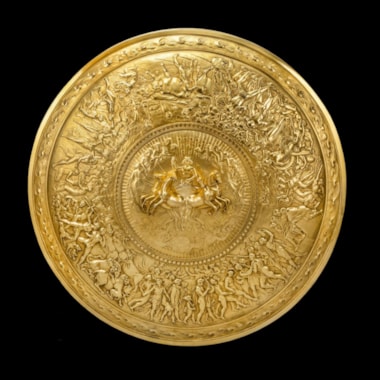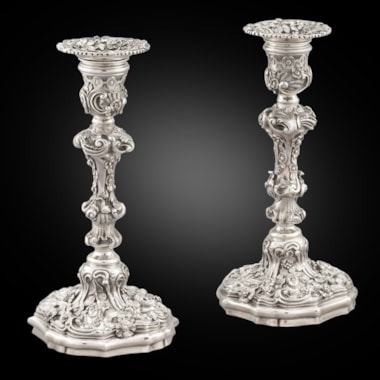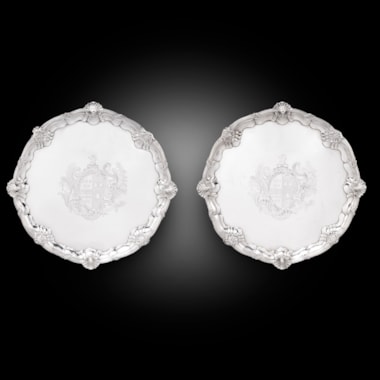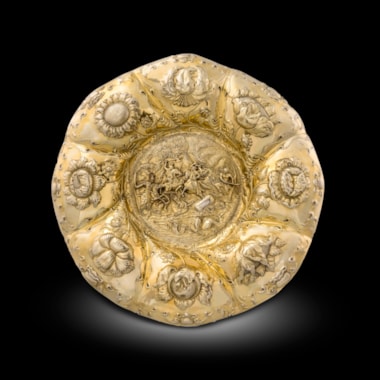Of rectangular shape, the border decorated with gadroons and shells. The handles in the shape of acanthus buds.
TUCKER, K.C.B. (Rear-Admiral of the Red, 1841. f-p., 22; h-p., 34.)
Sir Edward Tucker entered the Navy, 2 May, 1791, as Captain’s Servant, on board the Aquilon 32, Capt. Hon. Robt. Stopford, stationed in the Mediterranean. In Dec. 1793 he removed as Midshipman (he had already attained that rating) to the Adventure 44, Capt. Edw. Buller; under whom, after serving for upwards of 12 months on the coast of North America, he proceeded in the Crescent frigate to the Cape of Good Hope; where he became Master’s Mate, in Aug. 1796, of the Monarch 74, flag-ship of Sir Geo. Keith Elphinstone, and where, from the following Sept. until his return to England in 1802, he officiated as Acting- Lieutenant and Lieutenant (commission dated 21 May, 1799) in the Sceptre 74, Capts. Thos. Alexander and Valentine Edwards, Rattlesnake 16 and Jupiter 50, both commanded by Capt. Wm. Granger, Lancaster 64, flag-ship of Sir Roger Curtis, and Star sloop, Capt. Gardner. He was present, in Aug. 1796, at the surrender of the Dutch squadron in Saldanha Bay. In the course of 1803-4 he was appointed in succession to the Malta 80, Capt. Edw. Buller, Galatea 32, Capt. Henry Heathcote, Inspector, Capt. Henry Budd, Euryalus 36, Capt. Hon. Henry Blackwood, and Circe frigate, Capt. Jonas Rose. In the ship last mentioned (the others were employed on the Home station) he proceeded to the West Indies; where he was made Commander, 22 Jan. 1806, into L’Epervier sloop. Attaining Post-rank 23 March, 1807, he was appointed, 1 Sept. following, to the Dover 38, and ordered to the East Indies. Towards the close of 1809, being still on that station, he was intrusted by the Commander-in-Chief, Rear-Admiral Wm. O’Brien Drury, with the charge of an expedition,[1] having for its object an attack upon the Moluccas. Soon after his arrival on the coast of Java he made prize, with his own ship and her boats, of two brigs, two sloops, one war-junk, and 15 proas, carrying altogether 50 guns, 4 six-inch swivels, and 380 men; and on 6 Feb. 1810 he took, at the end of a chase of five hours, and in spite of some opposition, the Dutch brigs-of-war Rembang of 18 long six-pounders and 100 men, and Hope of 10 guns and 68 men. On 17 of the same month the whole of the important island of Amboyna surrendered to the force under Capt. Tucker, although defended by numerous strong batteries, mounting in the whole between 200 and 300 pieces of cannon, and by 130 European and upwards of 1000 Javanese and Madurese troops, exclusive of the Dutch inhabitants and burghers, and of 220 officers and seamen, many of them Europeans, lately belonging to three vessels which had been sunk in the harbour.[2] The forts and batteries were nevertheless captured, and the colony, as stated, subdued by a comparative handful of men landed from the three ships, amounting in all to not more than 401 troops, seamen, and marines, under the personal direction of Capt.-Major Henry Court, of the E.I.Co.’s service.[3] The success of the British against Amboyna led to the almost immediate surrender, without resistance or bloodshed, of the valuable islands of Saparoua, Harouka, Nasso Laut, Bouro, and Manippa. About the same period Capt. Tucker captured two large ships, a brig, and a ketch, from Souroubaya, richly laden with supplies of every kind for the governments of Amboyna, Banda, and Ternate. His squadron, between 5 March and 29 April following, took, further, one ship, six brigs, and four sloops, all armed, and laden with supplies for Ternate, Bandon, &c. Capt. Spencer, also, of the Samarang, made a successful attack upon the fort of Pulo-Ay, whence he removed the garrison, ordnance, and public property. Having sent the prisoners taken at Amboyna and the other islands to Java, Capt. Tucker proceeded to Gorontello, on the north-east part of Celebes, where he induced the Sultan and his two sons, in whose hands the whole settlements had been invested for the Dutch East India Company, to haul down the Batavian and substitute the British flag. On arriving next at Manado he sent a summons to the Governor of Fort Amsterdam, who, although he possessed defences which mounted 3 12-pounders, 5 8-pounders, 10 6’s, and 32 pieces of smaller calibre, instantly accepted the terms proposed to him – 102 Dutch officers and soldiers and 11 seamen laying down their arms. With Manado fell its dependencies, the ports of Kemar, Le Copang, Amerang, and Tawangwoo. At these places were found supplies on the eve of being shipped off for Banda – a circumstance which rendered their capture the more important.[4] Capt. Tucker continued to hold the conquests he had made, notwithstanding the slender force at his command, until the arrival, some months afterwards, of reinforcements from India. He then returned to Madras, without having sustained a single loss from sickness, and with his ship in so complete a state that he immediately volunteered to accompany the expedition then about to proceed to Batavia. Circumstances, however, prevented his doing so. He left the Dover in April, 1811 (she was wrecked 2 May following, while under the temporary command of Lieut. Chas. Jefferis); and he was afterwards appointed – 13 Oct. 1812, to the Surveillante 38, on the north coast of Spain – and in the early part of 1813, to the Cornwall 74 and Inconstant 36. In the latter ship, which he paid off in Aug. 1815, he made a voyage to Buenos Ayres. He was Knighted for his services 6 May, 1813, and nominated a K.C.B. 2 Jan. 1815. His promotion to Flag-rank took place 23 Nov. 1841.
He married, in Feb. 1817, a sister of the present Capt. Sir Henry John Leeke, R.N., Kt., K.H. Agents – Messrs. Ommanney.
1. Consisting, with the Dover, of the Cornwallis 44, Capt. Wm. Augustus Montagu, and Samarang 18, Capt. Rich. Spencer. The Cornwallis did not join until 9 Feb. 1810.
2. The Mandurese of 12 guns (afterwards weighed by the British), San Pan cutter of 10 guns, and a cutter, name unknown, of 12 guns.
3. The courage and sound judgment displayed by Capt. Tucker in the operations he conducted against Amboyna were warmly praised by Rear-Admiral Drury. – Vide Gaz. 1810, p. 1481.
4. Vide Gaz. 1811, p. 497.
Son of Thomas Storr of Westminster, first silver-chaser later innkeeper, born 1771. Apprenticed c'1785. Before his first partnership with William Frisbee in 1792 he worked at Church Street, Soho, which was the address of Andrew Fogelberg. This is also the address at which Storr's first separate mark is also entered. First mark entered as plateworker, in partnership with William Frisbee, 2 May 1792. Address: 5 Cock Lane, Snow Hill. Second mark alone, 12 January 1793. Address: 30 Church Street, Soho. Third mark, 27 April 1793. Fourth 8 August 1794. Moved to 20 Air Street, 8 October 1796, (where Thomas Pitts had worked till 1793). Fifth mark, 29 November 1799. Sixth, 21 August 1807. Address 53 Dean Street, Soho. Seventh, 10 February 1808. Ninth, 21 October 1813. Tenth, 12 September 1817. Moved to Harrison Street, Gray's Inn Road, 4 March 1819, after severing his connection with Rundell, Bridge and Rundell. Eleventh mark, 2 September 1883. Address: 17 Harrison Street. Twelfth and last mark, 2 September 1833. Heal records him in partnership with Frisbee and alone at Cock Lane in 1792, and at the other addresses and dates above, except Harrison Street. Storr married in 1801, Elizabeth Susanna Beyer of the Saxon family of piano and organ builders of Compton Street, by whom he had ten children. He retired in 1838, to live in Hill House in Tooting. He died 18 March 1844 and is buried in Tooting Churchyard. His will, proved 3 April 1844, shows an estate of £3000. A memorial to him in Otely Church, Suffolk was put up by his son Francis the then incumbent of the parish. For full details of Storr's relationship with Rundell, Bridge and Rundell please see N.M. Penzer, 1954 or Royal Goldsmiths, The Art of Rundell and Bridge, 2005.
Storr's reputation rests on his mastery of the grandoise neo-Classical style developed in the Regency period. His early pieces up to about 1800 show restrained taste, although by 1797 he had produced the remarkable gold font for the Duke of Portland. Here, however the modelling of the classical figures must presumably have been the work of a professional sculptor, as yet unidentified, and many of the pieces produced by him for Rundell and Bridge in the Royal Collection must have sprung from designs commissioned by that firm rather than from his own invention. On the other hand, they still existed in his Harrison Street workshop, until destroyed in World War II, a group of Piranesi engravings of classical vases and monuments bearing his signature, presumably used as source material for designs. The massiveness of the best of his compositions is well shown in the fine urn of 1800 at Woborn Abbey, but the Theocritus Cup in the Royal Collection must be essentially ascribed to the restraint of its designer John Flaxman, while not denying to Storr its superb execution. Lord Spencer's ice pails of 1817 show similar quality. Not all Storr's work however was of classical inspiration. The candelabra of 1807 at Woburn derive from candlesticks by Paul Crespin of the George II period, formerly part of the Bedford Collection, and he attempted essays in floral rococo design from time to time, which tend to over-floridity. On occasions the excellence of his technical qualities was marred by a lack of good proportions, as in the chalices of the church plate of St Pancras, 1821. In spite of these small lapses there is no doubt that Storr rose to the demands made upon him as the author of more fine display plate than any other English goldsmith, including Paul De Lamerie, was ever called upon to produce.
You May Also Like








































































